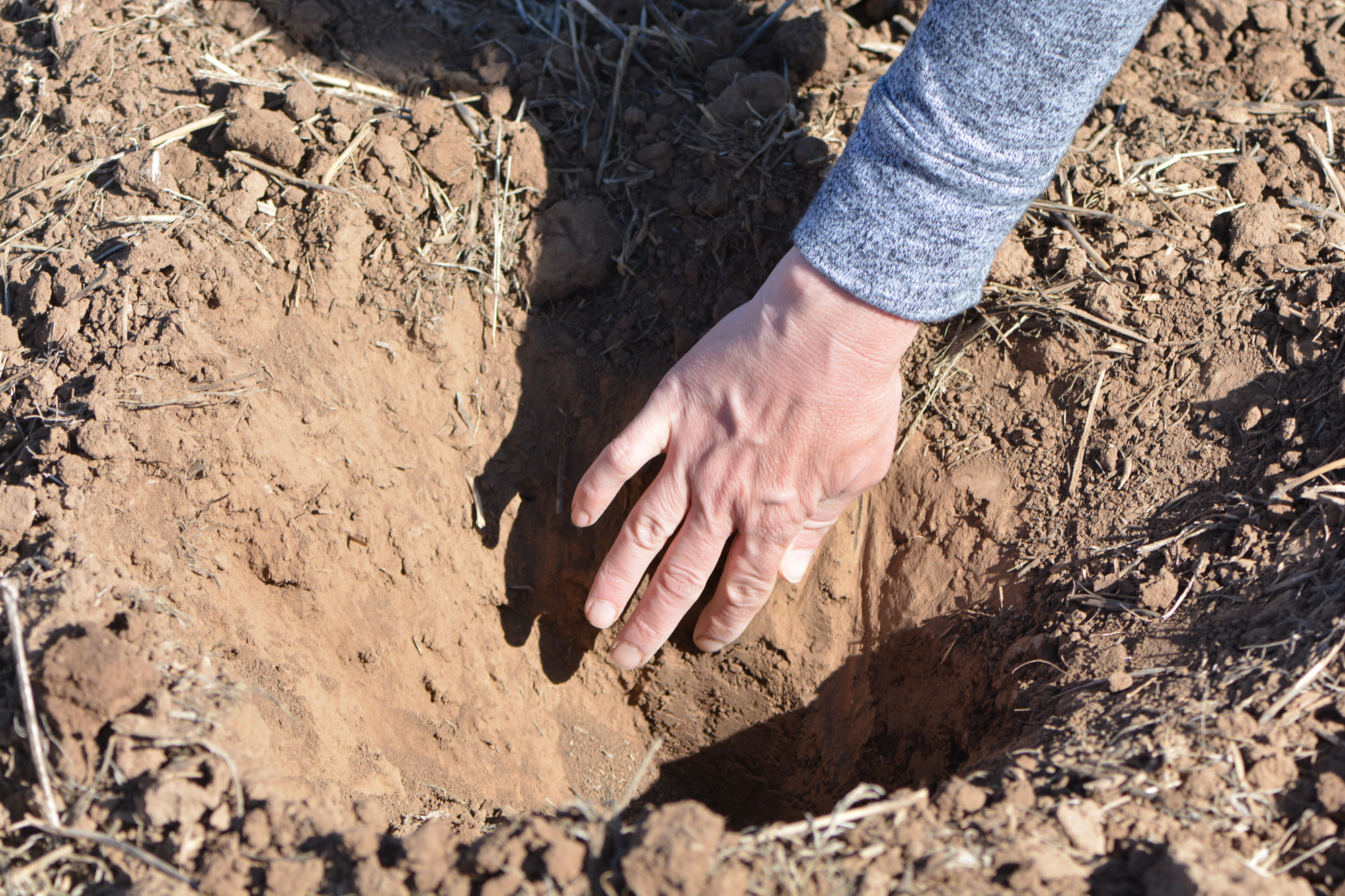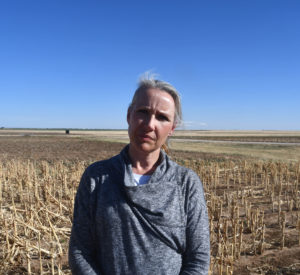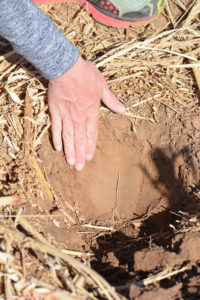Farm & Ranch
[AgriLife Today] Critical Texas drought forecast may alter summer crop planting decisions

By: Kay Ledbetter
Writer: Kay Ledbetter, 806-677-5608, [email protected]
Contacts: Dr. Jourdan Bell, 806-677-5600, [email protected]
AMARILLO – The Texas High Plains is under extreme drought and if current conditions continue, producers need to make important decisions for summer crops, said Dr. Jourdan Bell, Texas A&M AgriLife Extension Service agronomist in Amarillo.

Dr. Jourdan Bell, Texas A&M AgriLife Extension economist, said the lack of moisture over the winter may have High Plains producers tweaking their planting decisions. (Texas A&M AgriLife photo by Kay Ledbetter)
“The current U.S. Drought Monitor is reporting we are in a Stage 4 drought,” Bell said. “With that, many producers are having to make critical management considerations as they are approaching summer planting season.”
Fortunately, the region’s extended precipitation forecast is improving, she said. The National Weather Service Climate Prediction Center is now predicting the region will have equal changes of above or below average precipitation.
“What does that mean for a producer? Well hopefully it will not be as dry as previously predicted, but we still do not have a positive forecast,” Bell said. “Unfortunately, temperatures are still projected to be above average, and because temperatures are a key driver in crop water use, we are still at risk for crop stress under dryland and limited irrigation.”
With summer planting, it is important to know how much moisture is in the soil profile, “because that is our bucket,” Bell said. “With that, it’s also important to know what crops will be planted and what is their rooting depth. That will help us determine how much subsoil moisture we have and how far it will carry a crop through the growing season, especially if we don’t receive timely moisture.”
Many producers are having to pre-irrigate, so they can have sufficient moisture in the seed zone to germinate summer crops, she said. Under dryland situations, producers are having to decide if they are going to postpone planting.
“Our current forecast is actually calling for precipitation. If we do get rain, many producers are evaluating how soon they will plant dryland acreage,” Bell said. “But even with a precipitation event, it will depend on the amount of rain we receive and the rate it falls to determine the effectiveness of the precipitation event. One rain is not going to break the drought situation we are in.”

Subsoil moisture is only about 4-6 inches below the surface in fields where residue was left standing. (Texas A&M AgriLife photo by Kay Ledbetter)
The Texas High Plains is dependent on winter precipitation in the form of snowfall to build up soil moisture during the fallow period, she said. Across the region, negligible snow fell this winter and rainfall has been anywhere from less than a tenth of an inch to about 3/10s of an inch for the entire winter.
“On the bright side, we are very fortunate because we had very good early fall precipitation, so in many areas we still have good subsoil moisture,” Bell said.
She estimated under no-till and especially under good residue, soil moisture may be 4-6 inches deep; under cultivated or tilled ground, subsoil moisture may be 8-10 inches.
“It is important for producers to evaluate the depth to moisture before they begin to pre-irrigate,” Bell said. “Soil moisture sensors are an invaluable tool not only for scheduling in-season irrigation, but also determining how much pre-irrigation is needed.”
That subsoil moisture also allows dryland producers to gauge precipitation in the forecast to determine if it will give them enough moisture to plant on, she said.
“Even if we receive up to a half inch, that’s probably not going to be enough, because roots will not grow through dry soil to reach the wetter subsoil.”
The primary crops grown in this region under irrigation are corn and cotton, she said. As producers evaluate the forecast and probability of precipitation, many are opting to split irrigated acreage between corn and cotton so they will have sufficient water to meet critical crop water demands throughout the summer.
“For crop insurance purposes, corn needs to be planted on or before June 5 for counties in the Texas High Plains, but planting later in June shifts the critical water demand period of tasseling out of some of the hotter periods of summer,” Bell said.
“Often we will see greater kernel set and sometimes benefits by planting that crop even later in the summer. So, producers have to evaluate how they manage their insurance programs with regards to their planting times.”
For grain sorghum under both irrigated and dryland production systems, producers do have flexibility with planting dates, she said.
“We do find producers are able to make a very good sorghum crop, even planting into late June. That does provide a little bit a flexibility as they watch the weather,” she said. “They can wait and plant the crop if we receive timely rains. Also, planting later will move that critical growth stage of growing-point differentiation and flowering later into the season when we are not as hot. Sorghum does have a little more flexibility than cotton.”
When it comes to cotton across the High Plains, it is important for producers to get the crop planted in May because “we are trying to grow a perennial crop in a very short annual environment,” Bell said. “In order to accumulate sufficient growing degree days or heat units to mature that crop and optimize production – not just yield but also quality – we really need to get that crop off and running in May and preferably early to mid-May if conditions are favorable.”
Another challenge producers may have, especially under dryland conditions, is herbicides, she said. In some years, sufficient precipitation is not received to activate some of the residual preplant herbicides.
“Preplant herbicides are very important because we want to minimize competition with our primary crop,” Bell said. “We want to start the season weed free. Weeds are using water we need for the crop, so they must be managed.”
All these decisions can be tricky because producers often have made their seed selection months ago, she said. So moving into a dry period there might be some limitations on the decisions a producer can make.
“Irrigation helps stabilize production and minimizes the risk we encounter under dryland,” Bell said. “But across much of the High Plains, well capacities are no longer sufficient to meet crop water demands to optimize economical production. And often our precipitation, while aiding crop water demand throughout the season, doesn’t come at the most ideal time.”
She said the High Plains often receives non-beneficial precipitation. Rain events may only measure a few hundredths of an inch or 2-3 inches may fall in a very short time and a large percentage of this runs off. Neither event benefits crop production.
“Really, what we want to see are those slow, steady rains that come over the course of several days and soak in, wet up that profile, and really provide soil moisture.”
Traditionally the best rains in this region fall in May and June, and that offers hope for the coming crop season, in spite of the current drought, Bell said.
-30-
Find more stories, photos, videos and audio at http://today.agrilife.org
Farm & Ranch
Managing Show Cattle Through The Winter

By Heather Welper
Husband and wife duo, Heather and Calvin Welper, are the Co-Owners and Operators or Two C Livestock, located in Valley View, Texas.
The pair’s operation has a show cattle focus where they raise and sell purebred heifers of all breeds and club calf Hereford steers.
When it comes to show cattle, the Welpers know a thing or two including how to prepare for the cold winter months and the Texas major show season run.
To read more, pick up a copy of the November edition of North Texas Farm & Ranch magazine, available digitally and in print. To subscribe by mail, call 940-872-5922.

Farm & Ranch
Double M Ranch & Rescue

By Hannah Claxton, Editor
As the sun rises each day, so do the dozens of mouths that Meghan McGovern is responsible for getting fed. Rather than the sounds of a rooster crowing, McGovern hears the bellows and bleats of a variety of exotic deer, the chortle of kangaroos, the grunts of water buffaloes, and the chirps of a lemur.
Nestled against the banks of the Red River, the Double M Ranch and Rescue, with its high game fences and deer sprinkling the landscape,s its in stark contrast to the surrounding ranches.
“Having deer is kind of like eating potato chips- you can never actually have just one,” said McGovern with a laugh.
McGovern has several herds to take care of- fallow deer, axis deer, water buffalo, goats, and bison. In smaller numbers, there’s also a few kangaroos, a lemur, a potbelly pig, a pair of zebras, a watusi, and a few horses.
To read more, pick up a copy of the November edition of North Texas Farm & Ranch magazine, available digitally and in print. To subscribe by mail, call 940-872-5922.

Farm & Ranch
Acorn Toxicity

By Barry Whitworth, DVM, MPH
With the prolonged drought, most pastures in Oklahoma end up in poor condition. With the lack of available forage, animals may go in search of alternative foods.
If oak trees are in the pastures, acorns may be a favorite meal for some livestock in the fall. This may result in oak poisoning.
Oak leaves, twigs, buds, and acorns may be toxic to some animals when consumed.
To read more, pick up a copy of the November edition of North Texas Farm & Ranch magazine, available digitally and in print. To subscribe by mail, call 940-872-5922.

-

 Country Lifestyles2 years ago
Country Lifestyles2 years agoScott & Stacey Schumacher: A Growth Mindset
-

 Country Lifestyles8 years ago
Country Lifestyles8 years agoStyle Your Profile – What your style cowboy hat says about you and new trends in 2017
-

 HOME8 years ago
HOME8 years agoGrazing North Texas – Wilman Lovegrass
-

 Outdoor10 years ago
Outdoor10 years agoButtercup or Primrose?
-

 Country Lifestyles5 years ago
Country Lifestyles5 years agoAmber Crawford, Breakaway Roper
-

 Country Lifestyles9 years ago
Country Lifestyles9 years agoJune 2016 Profile – The man behind the mic: Bob Tallman
-

 Country Lifestyles8 years ago
Country Lifestyles8 years agoDecember 2016 Profile, Rusty Riddle – The Riddle Way
-

 Equine1 year ago
Equine1 year agoThe Will to Win




